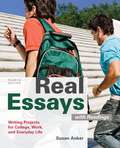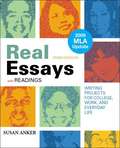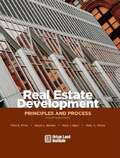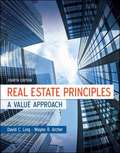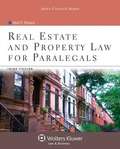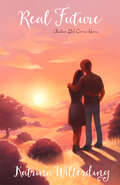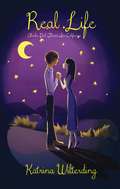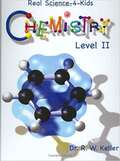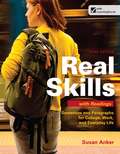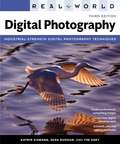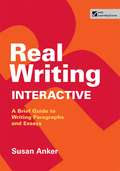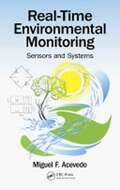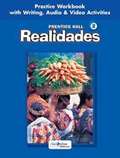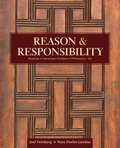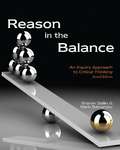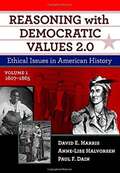- Table View
- List View
Real Essays With Readings: Writing For Success in College, Work, and Everyday Life (Fourth Edition)
by Susan AnkerReal Essays delivers the powerful message that good writing, thinking, and reading skills are both essential and achievable. From the inspiring stories told by former students in Profiles of Success to the practical strategies for community involvement in the new Community Connections, Real Essays helps students to connect the writing class with their real lives and with the expectations of the larger world. So that students don't get overwhelmed, the book focuses first on the most important things in each area, such as the Four Most Serious Errors in grammar; the Four Basics of each rhetorical strategy; and the academic skills of summary, analysis, and synthesis. Read the preface.
Real Essays with Readings: Writing Projects for College, Work, and Everyday Life 3rd Ed
by Susan AnkerReal Essays is the essay-level book in Susan Anker's highly successful series of writing texts that motivate students with their message that writing is an essential skill in college and in real life-and that this skill is achievable. It maintains its emphasis on what really matters by focusing on the four most serious errors (fragments, run-ons, subject-verb agreement problems, and verb form problems) and gives students what they need to succeed in college and become stronger academic writers.
Real Estate Development: Principles and Process
by Mike E. Miles Marc A. Weiss Gayle L. Berens Mark J. EppliIdeal for anyone new to real estate development, the fourth edition of this bestselling book covers each stage of the process step by step, explaining the basics of idea conception, feasibility, planning, financing, market analysis, contract negotiation, construction, marketing, and asset management. Thoroughly updated, the book includes material on financing and marketing.
Real Estate Principles
by Charles J. JacobusFor decades this popular principles book has laid a solid foundation for thousands of new real estate professionals like you starting a rewarding career in the real estate industry. <P><P>Known for his clear presentation and engaging style, Charles Jacobus brings together all the pieces of real estate giving you the fundamentals they need for success. <P><P>This best-selling principles book has been updated to reflect numerous changes in modern real estate practice. <P><P>Particular attention has been given to new regulations in the mortgage industry while still reinforcing the core concepts that have been the cornerstone of American real estate ownership.
Real Estate Principles: A Value Approach
by David Ling Wayne ArcherReal Estate Principles: A Value Approach demonstrates how value is central to virtually all real estate decision-making. Students using Ling and Archer should finish the course with a value-oriented framework and a set of valuation and decision making tools that can be applied in a variety of real-world situations. The key to making sound investment decision is to understand how property values are created, maintained, increased or destroyed. <p><p> Since the launch of Real Estate Principles: A Value Approach, significant and lasting changes have come upon the world of real estate. This is very true in real estate finance and capital sources where most of the traditional lenders have been transformed or displaced, giving way to a radically different set of players in mortgage finance. There has been change with profound and far-reaching implications in a world where it is understandable that property values can go down as well as up. This realization will color every aspect of real estate investment, finance and transactions for the foreseeable future.
Real Estate and Property Law for Paralegals
by Neal R. Bevans BevansReal Estate and Property Law for Paralegals provides a solid foundation in the basics including the practicalities of daily legal work. Its broad coverage of all the key topics that paralegals need to know includes basic elements of real property, different methods used to record and describe property, transfer of title, the rights associated with real estate ownership,elements of real estate contracts, landlord/tenant law, deeds, mortgages,restrictions on land use, title insurance and title examinations, the closing process, and tax implications. Practical skills are emphasized throughout the book so that students will develop a true understanding of what it is like to practice in the real world. An easy-to-read and engaging style utilizes numerous examples and illustrations, always emphasizing the practical nature of real estate law. Each chapter opens with objectives and closes with Key Terms, Review Questions, and Practical Applications exercises. In every chapter, an "Issue at a Glance" box summarizes important legal concepts, and"Skills You Need in the Real World" sections highlight particular paralegal skills. Marginal definitions; numerous figures, tables, and forms; and case excerpts that discuss legal theory and applications round out the significant pedagogy. Additionally, Websites that can help students gather more information are strategically placed. An in-depth Instructor's Manual includes a test bank, lesson plans, suggested syllabi, web resources, additional assignments and PowerPoint slides for each chapter. The revised Third Edition provides a wealth of updated forms and cases. New website references make the book current, and fine-tuned text discussions have been expanded where appropriate. A new interactive workbook is available at the website to accompany the book.
Real Future: Alaskan Girl Comes Home
by Katrina WilterdingWe can shape our future. Every day we make decisions that set us on the path to something more significant than the day-to-day. Our destiny is what we make it. Real Future gives hope. It allows us to realize there is something to look forward to beyond this life. It gives readers a glimpse into something bigger than our daily existence. Take a moment to examine your future just as the characters in Real Future do, and in so doing, take the leap of faith to shape your destiny.
Real Life: Alaska Girl Thaws In California
by Katrina WilterdingIf you think high school is bad, wait until real life starts. Real life? What does that mean? How is love, death, grief, and joy not real life? So much can happen in just a short time. Four years, the amount of time in high school on average. Four days, the amount of time before astronauts on the Apollo 11 mission walked on the moon after leaving Earth. Four hours, the time it takes to fly from Anchorage to San Francisco. Four seconds, the time it takes to say "I do" on your wedding day. It does not take much to change a life forever. Real Life tells the story of a little over four months in the lives of two high school students. Four months was all it took to rearrange their lives for forever.
Real Science-4-kids Chemistry Level 2 Student Text
by Rebecca Keller KellerReal Science-4-Kids, Chemistry Level II, Student Textbook
Real Skills Essentials: From Sentence to Paragraph
by Susan Anker Miriam MooreWords, and the ways we put them together, help us accomplish ordinary tasks and (as our skills improve) some incredible feats: getting a date, making a sale, convincing the boss to try a new idea, changing a law, or solving a long-standing problem. The words we use to read and write can also help us to think more creatively, more deeply, and more effectively. In Real Skills Essentials, I wanted to help you see the value of skills like reading, thinking, and writing. It takes time and attention to learn new words, understand them when you read, and master rules for combining and punctuating them accurately. But in the end, after working for these skills, you will begin to see them working for you. It will be worth the effort.
Real Skills With Readings: Sentences and Paragraphs for College, Work, and Everyday Life
by Susan AnkerReal Skills with Readings offers practical, accessible coverage of basic sentence skills and step-by-step guidance on writing paragraphs. Like the other books in the Anker series, Real Skills motivates students with its message that writing is an essential and achievable skill. Real Skills connects engaging grammar and writing instruction with an emphasis on critical thinking and reading skills -- the keys to successful writing. Real-world examples, assignments, and readings show students the relevance of writing to all aspects of their lives. Real Skills with Readings is now integrated with LearningCurve -- online, adaptive quizzing activities that reinforce what students learn in the book.
Real World Digital Photography (3rd Edition)
by Katrin Eismann Sean Duggan Tim GreyIntended for beginner to intermediate photographers, this guide provides a foundation in the fundamentals of digital photography from discussions of basic equipment to post-production techniques. Divided into sections covering cameras and accessories, photography fundamentals, digital processing and presentation and output, chapters provide both theory and practical instruction and include detailed color example photographs and illustrations of techniques. This third edition is updated to include the latest camera technologies. The authors are professional photographers and photography writers. Annotation ©2011 Book News, Inc. , Portland, OR (booknews. com)
Real World Psychology
by Karen Huffman Catherine A. SandersonReal World Psychology balances comprehensive coverage of the key concepts in introductory psychology with a concise presentation style and engages students with current and interesting research that explores these concepts in real-life contexts. Real World Psychology features the incomparable author team of Karen Huffman (Palomar College) and Catherine Sanderson (Amherst College) who create an outstanding text that is appealing to students and instructors at a wide range of academic institutions. The new edition has been thoroughly updated and features a new focus on Scientific Thinking and Practical Applications underscoring the fact that connecting the principles of psychological science to everyday life is critical to student engagement, and ultimately key to their success – not only in the introductory psychology course, but in whatever their chosen field of study and in everyday life. Students will leave the course with an appreciation of how a basic, yet scientific understanding of human behavior can benefit them in their studies, in their personal lives, and in their professional endeavors.
Real Writing Interactive
by Susan AnkerReal Writing Interactive offers practical coverage of writing skills and step-by-step guidance on crafting paragraphs and essays in a brief, interactive, and affordable format. The print component offers the essentials of Anker's accessible writing instruction along with select exercises; additional exercises are available online in LearningCurve, adaptive, game-like quizzing that helps students focus on the material they most need help with. As with all books in the Anker series, Real Writing Interactive motivates students with its message that writing is an essential and achievable skill and encourages students to connect what they learn with their own goals and with the needs and expectations of the larger world.
Real-Time Environmental Monitoring: Sensors and Systems
by Miguel F. AcevedoThe natural environment is complex and changes continuously at varying paces. Many, like the weather, we notice from day to day. However, patterns and rhythms examined over time give us the bigger picture. These weather statistics become climate and help us build an understanding of the patterns of change over the long term. <p><p> Real-Time Environmental Monitoring: Sensors and Systems introduces the fundamentals of environmental monitoring, based on electronic sensors, instruments, and systems that allow real-time and long-term data acquisition, data-logging, and telemetry. <p><p> The book details state-of-the-art technology, using a practical approach, and includes applications to many environmental and ecological systems. In the first part of the book, the author develops a story of how starting with sensors, you can progressively build more complex instruments, leading to entire systems that end with databases and web servers. In the second part, he covers a variety of sensors and systems employed to measure environmental variables in air, water, soils, vegetation canopies, and wildlife observation and tracking. <p><p> This is an emerging area that is very important to some aspects of environmental assessment and compliance monitoring. Real-time monitoring approaches can facilitate the cost effective collection of data over time and, to some extent, negate the need for sample, collection, handling, and transport to a laboratory, either on-site or off-site. It provides the tools you need to develop, employ, and maintain environmental monitors.
Realidades 1: Leveled Vocabulary and Grammar Workbook
by Prentice-Hall Staff BoylesNIMAC-sourced textbook
Realidades 2: Level 2
by Peggy Palo Boyles Prentice Hall Dictionary EditorsRealidades 2 (English and Spanish Edition)
Realidades Level 2 Workbook
by Peggy Palo Boyles Myriam Met Richard S. Sayers Carol Eubanks WarginA Spanish-English learning work book.
Really Weird Sports (Fountas & Pinnell Classroom, Guided Reading)
by Devra SperegenNIMAC-sourced textbook
Reason and Responsibility: Readings in Some Basic Problems of Philosophy (Mindtap Course List)
by Russ Shafer-Landau Joel FeinbergREASON AND RESPONSIBILITY: READINGS IN SOME BASIC PROBLEMS OF PHILOSOPHY has a well-earned reputation for clarity and breadth, with a proven selection of high-quality readings that cover centuries of philosophical debate. The anthology includes the central issues in metaphysics, epistemology, philosophy of religion, philosophy of mind, and ethics, as well as debates over the value of philosophy and the meaning of life. The book is clearly organized so that the readings complement each other, guiding readers through contrasting positions on key philosophical issues. Clear, concise introductions provide reading tips and background information to help readers engage directly and meaningfully with the primary sources.
Reason in the Balance: An Inquiry Approach to Critical Thinking
by Sharon Bailin Mark BattersbyReason in the Balance focuses broadly on the practice of critical inquiry, the process of carefully examining an issue in order to come to a reasoned judgment. This text emphasizes the various aspects that go into the practice of inquiry, including identifying issues and relevant contexts, understanding competing cases, and making a comparative judgment. Distinctive Features of the Text are: Emphasis on applying critical thinking to complex issues with competing arguments; Inclusion of chapters on inquiry in specific contexts; Attention to the dialogical aspects of inquiry, including sample dialogues; Emphasis on the spirit of inquiry. The Second Edition Features: (i) updated examples and items of current interest (ii) new dialogues on vaccination, prostitution, and climate change (iii) new material on biases in reasoning, including emotional and psychological, social, and cognitive biases (iv) material on deduction and formal logic supplemented with Appendix on Logic on the Web site, including links for further learning and practice.
Reasoning With Democratic Values 2. 0: Ethical Issues In American History, Volume 1: 1607-1865
by David E. Harris Anne-Lise Halvorsen Paul F. DainNow thoroughly updated and extensively revised for use in today’s history classrooms, this time-honored classic has never been more important than right now. <p><p>The new edition, Reasoning with Democratic Values2.0, presents an engaging approach to teaching U.S. history that promotes critical thinking and social responsibility. <p><p>In Volume 1 students investigate 20 significant historical episodes, arranged chronologically, beginning with the colonial era and ending with Reconstruction. Each carefully researched story examines an ethical decision made by an individual or group from the American past, and is guaranteed to excite students’ imaginations and spark lively classroom discussions involving core values of American democracy—liberty, equality, life, property, truth, and diversity. <p><p>The discussions aim to develop more mature moral reasoning by students while deepening their knowledge of American history. Each chapter contains five types of learning activities: Facts of the Case, Historical Understanding, Expressing Your Reasoning, Key Concepts from History, and Historical Inquiry. <p><p> In Volume 1, students can grapple with such ethical dilemmas as: <p> Should the Commonwealth of Massachusetts have granted reparation to the enslaved woman, Belinda Royall? <p>Should Thomas Jefferson have freed his slaves? <p>Should Juan Seguín have fought against the United States in the Mexican–American War? <p>Should Robert E. Lee have accepted command of the Union Army? <p><p>You can also purchase a comprehensive Instructor’s Manual that includes the rationale for the teaching approach, guidance for selecting chapters, direction for leading classroom discussions of ethical issues, suggestions for assessment and grading, answers for the learning activities, and more! <p><p> PROFESSIONAL DEVELOPMENT: The authors are available, at no fee, to conduct professional development programs for teachers and/or administrators regarding teaching with RDV 2.0. Visit www.rdv2.org for more details, including author contact information. The authors have committed their royalties to teacher education.
Rebel Sultans The Deccan from Khilji to Shivaj
by Manu S. PillaiA thousand fortunes were made in the Deccan, drawing the formidable envy of generations of Mughal emperors. In Rebel Sultans, Manu S. Pillai narrates the story of the Deccan from the close of the thirteenth century to the dawn of the eighteenth. Packed with riveting tales and compelling characters, this book takes us from the age of Alauddin Khilji to the ascent of Shivaji. We witness the dramatic rise and fall of the Vijayanagar empire, even as we negotiate intrigues at the courts of the Bahmani kings and the Rebel Sultans who overthrew them. From Chand Bibi, a valorous queen stabbed to death, and Ibrahim II of Bijapur, a Muslim prince who venerated Hindu gods, to Malik Ambar, the Ethiopian warlord, and Krishnadeva Raya on Vijayanagar’s Diamond Throne – they all appear in these pages as we journey through one of the most arresting sweeps of Indian history. Unravelling a forgotten chapter in our medieval past, Rebel Sultans reminds us of a different age and a different time in the Deccan – one that ended an empire and rewrote India’s destiny.
Rebound (Fountas & Pinnell Classroom, Guided Reading Grade 6)
by Patrick Jones Ben ShannonPLAYING DIRTY NUMBER 24 IS PLAYING DIRTY, AND NOTHING MAKES TITUS MORE ANGRY. BUT WILL ANGER HELP HIM WIN THE GAME? NIMAC-sourced textbook
